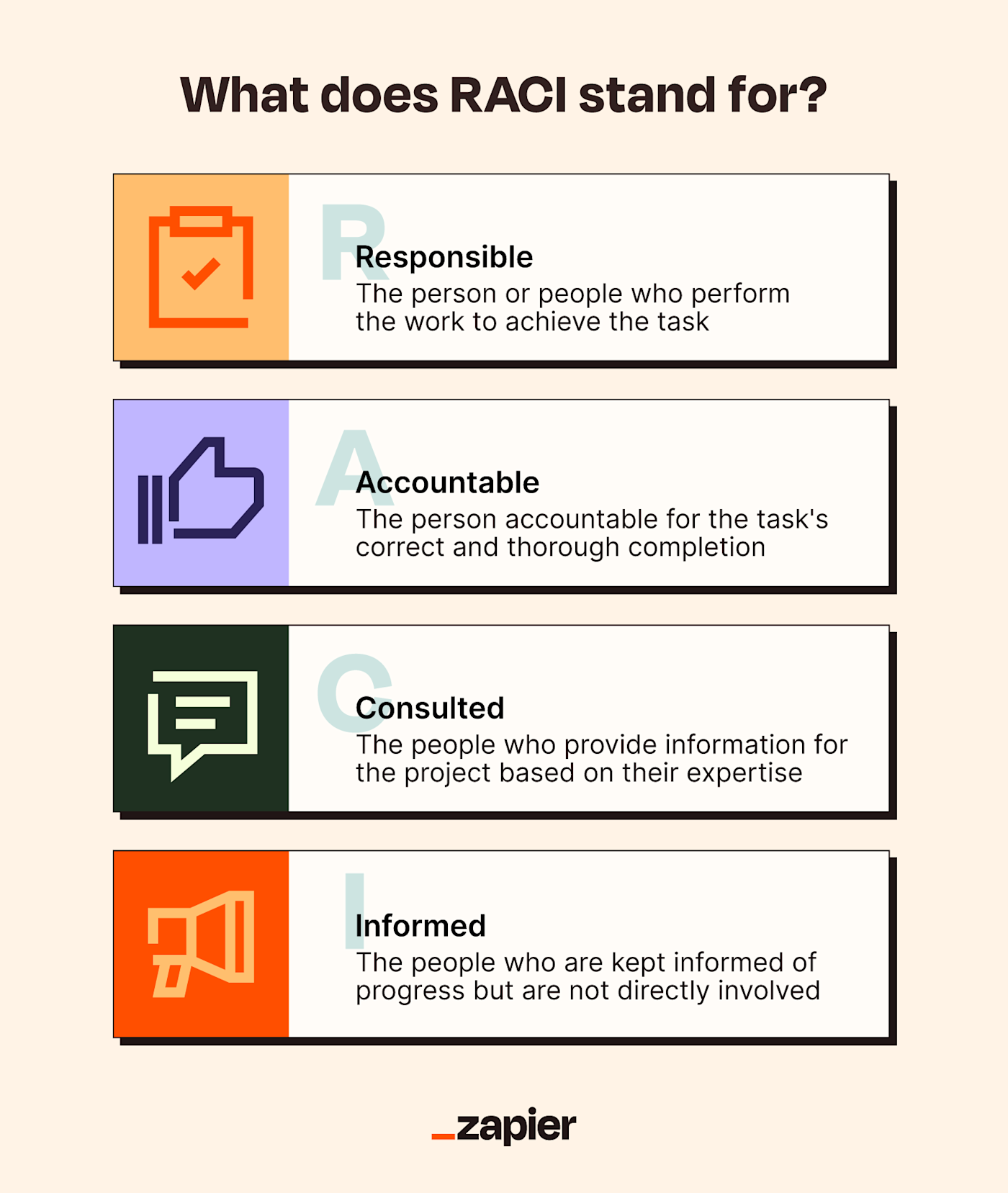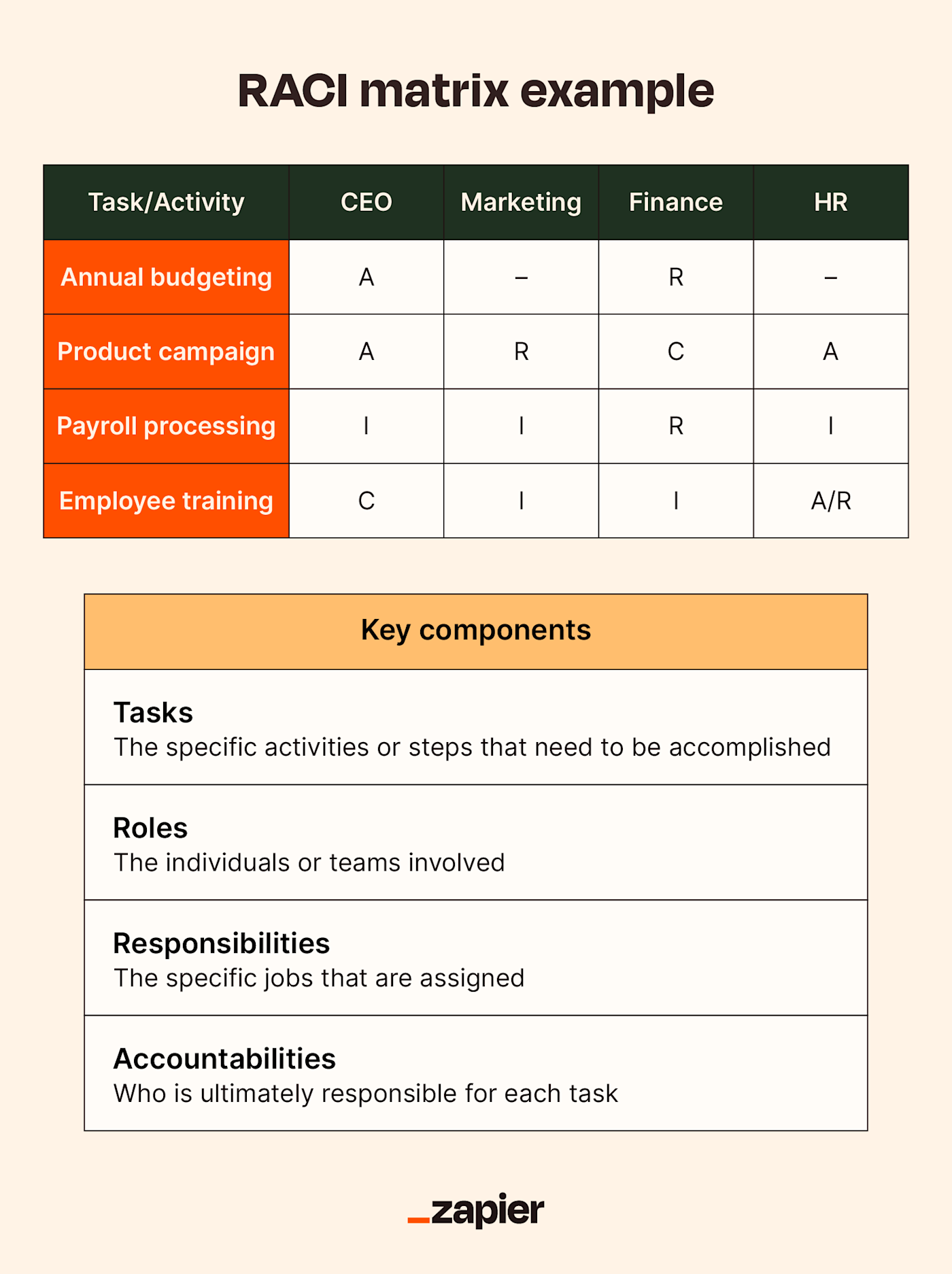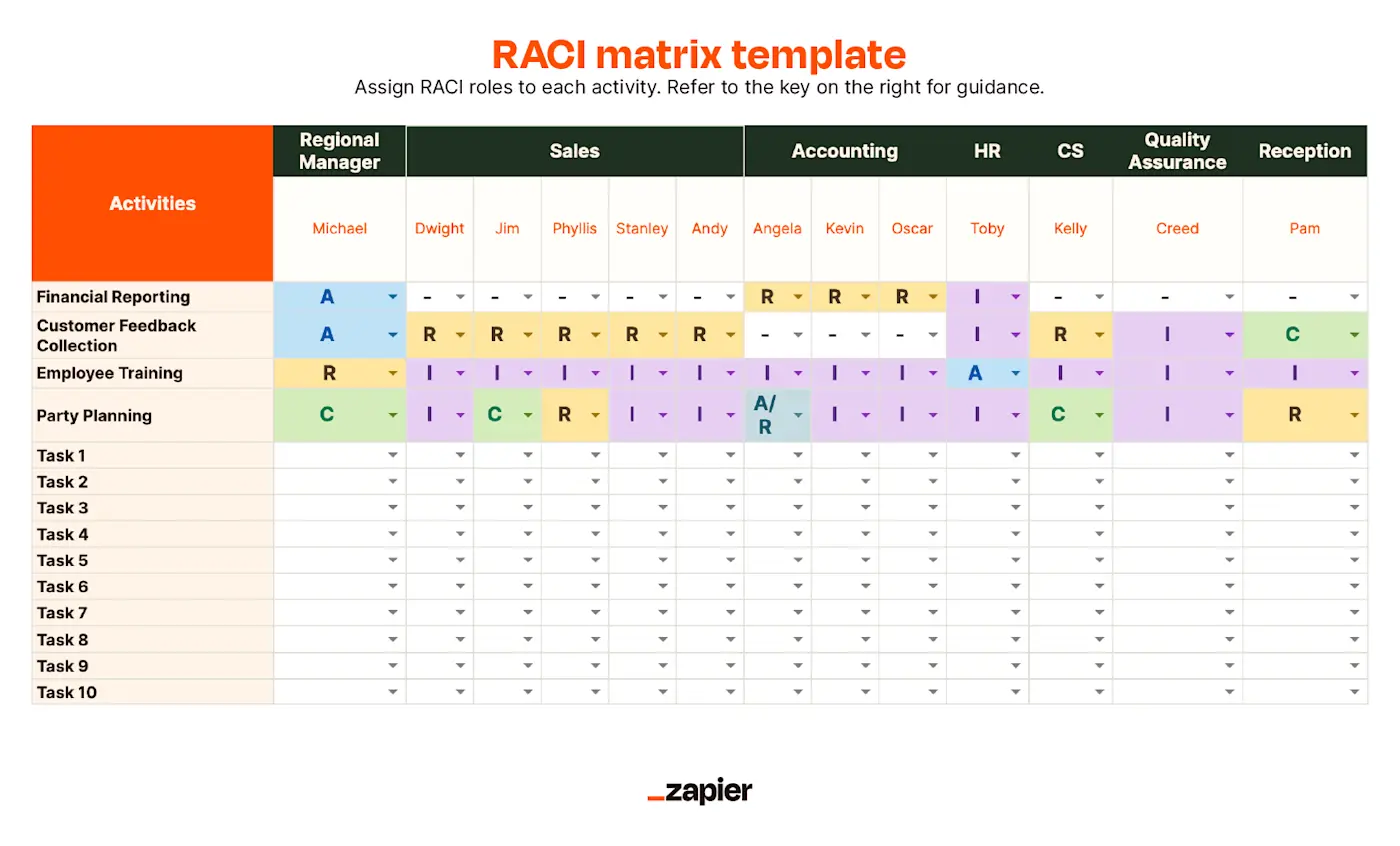A few weeks back, in a burst of misguided optimism, I found myself in an escape room with eight of my most brilliant friends. I was confident we'd bust out in record time, but we quickly realized our error: too many cooks, not enough coordination.
We really could have used RACI. The RACI model—which stands for responsible, accountable, consulted, and informed—would have gotten us the Instagram-worthy escape time we'd hoped for. This project management model ensures that there are clear roles, no conflicting ideas, and a clear communication process. Here, I'll unpack the RACI model and how it can streamline potentially chaotic projects—and perhaps save you from your own escape room disaster.
Table of contents:
What is the RACI model?
The RACI model, sometimes called a responsibility assignment matrix (RAM), is a project management tool for assigning roles and responsibilities to the various stakeholders of a project. Think of it as a roadmap for who's doing what. It's the secret ingredient to making sure your projects don't implode in a fiery mess of miscommunication, redundant work, and misalignment.
RACI is an acronym that stands for responsible, accountable, consulted, and informed. Let's break each of those down.
Responsible: This is the person who's actually doing the thing. Think creatives, developers, analysts, and other worker bees. If we're talking about making a sandwich, this is the person slapping the mayo on the bread.
Accountable: Typically in a leadership position, this is the person who's got the final say. If that sandwich ends up being terrible, this is who you send it back to.
Consulted: These are the folks you chat with before making decisions. Like, "Hey, do you think we should add pickles to this?" They give input, but they're not in the kitchen with you. In the work world, we're talking about people like subject-matter experts, legal teams, and quality assurance teams.
Informed: These people are just here for the updates. "Just so you know, we're going with pickles." Informed parties can include external stakeholders, end users, senior management, or anyone else who needs to know what's happening but isn't directly involved in the action.
Importantly, RACI isn't just for the overarching project—it's applied to each individual task within that project. You'll document your RACI roles in a RACI chart to be sure everything's clear and transparent—more on that below.

Why you need a RACI matrix
There's nothing worse than finding multiple people doing the same thing while working on a project, or neglecting an important task because everyone thinks it's not their job.
RACI is a management tool that helps distribute tasks and assign responsibilities in a clear and transparent way. It helps people know where to go for information or approval, prevents people from passing the buck, and makes sure everyone is clear on their primary responsibilities.
Key RACI benefits include:
Clearly defines responsibilities and expectations: No more "Well, finance said it was ready to ship..." moments. Everyone knows their role, and there's no stepping on toes.
Reduces workflow confusion: It's like having a map in a maze. You know exactly where to go and what to do without running into dead ends or, worse, minotaurs.
Enhances understanding and clarity: Because there's always someone accountable, decisions are decisive, and responsibilities are unmistakably defined. It's like translating everyone's thoughts into a universal language where "I thought you meant..." becomes a phrase of the past.
Flexible approach: RACI works for almost any project type. Whether setting up a new server or orchestrating a multi-channel marketing campaign, the RACI model can be tailored to fit your needs.
When should you use a RACI matrix?
You might ask yourself, "Self, how do I know when a RACI matrix is needed?" Let's sort that out.
Examples of projects where you should use RACI:
New product launch: Launching a new product isn't just about who's doing what. It's about understanding the decision-making hierarchy. Who gives the final nod for the marketing strategy? Who should be consulted about production timelines? With RACI, you're not just assigning tasks; you're clarifying the chain of command and consultation, ensuring a smoother launch process.
Office relocation: Ever tried moving your entire workspace without losing your favorite mug? Or your sanity? Who has the authority to choose the new location? If there's an issue with the new space, who's the point of contact? And before finalizing the seating arrangement, who should be consulted? RACI delegates tasks and defines the decision-making flow, ensuring a seamless transition.
Software implementation: Implementing new software isn't just about installation. Who approves the software choice? Who should you consult when deciding on configurations? And if things go sideways, who's the brave soul accountable for handling the fallout? RACI provides a clear roadmap of responsibility and consultation, ensuring the software rollout is successful.
Event planning: Organizing a corporate event or conference involves many moving parts. Who has the final say on the venue? Who gives approval when you need to know if karaoke is a yea or nay? And who should be consulted when deciding between a taco bar or sushi rolls? RACI helps you streamline the communication and decision-making processes.
Examples of projects where you shouldn't use RACI:
Simple tasks: If the task is straightforward, like "get more coffee filters for the break room," you probably don't need a matrix.
Short-term projects: If you're whipping up something quickly with a small team, the time spent creating a RACI might outweigh its benefits.
Well-established processes: For routine tasks that the team has been performing for years, introducing a RACI matrix is probably overkill.
What should a RACI matrix include?

A RACI chart has a specific structure. It's not just about listing out people's roles—to be effective, it needs a few other components.
Key components of a RACI matrix include:
Tasks: These are the specific activities or steps that need to be accomplished throughout the project. They form the backbone of the matrix, clarifying what needs to be done. Think of them as the items on your to-do list.
Roles: This refers to the individuals or teams involved in the project. From team members to stakeholders, this is everyone who's got some skin in the game.
Responsibilities: This is the nitty-gritty of who does what. It's where you hand out the jobs. Like, "Hey, you! You're on lead gen duty."
Accountabilities: This is the "buck stops here" role. It's about ownership, pinpointing who is ultimately answerable for the completion and quality of each task.
How to create a RACI matrix
Now that you know what RACI is, it's time to unpack the step-by-step process of crafting your own RACI matrix.
Map out the project landscape: Begin by pinpointing the scope of your project. What are the specific tasks that need to be accomplished? The level of detail is up to you. Put the tasks on the vertical left side of your chart. It's like making a grocery list, but with the added bonus of not having to decide if you really need that third pint of ice cream.
Identify key players: The lucky souls involved in this project are your stakeholders. They get prime real estate across the top of your chart.
Assignments: For each task, you'll want to determine who's responsible (the doer), who's accountable (the decision-maker), who needs to be consulted (the advisors), and who should be informed (the folks kept in the loop).
Share and review: Once your initial RACI matrix is set up, gather the crew for a review session. This collaborative approach ensures everyone agrees on their roles and responsibilities. It's an opportunity to clarify any ambiguities and hash out any disagreements so everyone's on the same page.
Stay adaptable and engaged: Projects evolve, and so should your RACI matrix. As you progress, changes or shifts might need to be addressed. Regularly revisit your RACI chart, tweak as needed, and keep communication lines open, making sure it remains a relevant and valuable tool.
And here are some golden rules for using the RACI model:
Every task should have at least one Responsible party. Someone's gotta roll up their sleeves and do it. Otherwise, it's just a free-for-all of "not my job" shrugs.
There is always one and only one Accountable for each task. Adding another is like having two quarterbacks in a football game. Unless you're the 2008 Miami Dolphins, it just doesn't work.
Only the Responsible and Accountable roles are mandatory for each task. This ensures that for every activity, there's someone doing the work and someone ensuring it's done right. Everyone else is just there for support.
Keep it simple. If your grandma can't figure out your RACI chart, you're doing it wrong. Make it clear and understandable.
And there you have it. With these ingredients and rules in hand, you're well on your way to creating a RACI chart that'll make your project run smoother than freshly churned butter.
Example RACI chart and template
A RACI matrix is where you can see who's doing what at a glance.
Project tasks are in the left column
Project roles are in the top row
Each task gets a letter: R, A, C, or I
Letters are applied at the intersections of rows and columns to signal which role is performing each task
Next time you're drowning in a sea of "Who's on first?" whip out this RACI template to chart your way to clarity. But remember: the magic isn't in the template, but in the thoughtful application of the RACI model.

RACI matrix alternatives
The RACI matrix is a staple in project management, but like with any tool, sometimes you need a different wrench for a different bolt. If RACI doesn't work for you, here are some alternatives.
RAS (Responsible, Approve, Support): This simplified version of RACI might be a good fit if your team doesn't need the "Consulted" and "Informed" distinctions. RAS is perfect for those "let's not make this harder than it needs to be" projects.
RAPID (Recommend, Agree, Perform, Input, Decide): This one's ideal for decision-making processes. If your project involves a lot of decisions that need input from various stakeholders, RAPID can help streamline who does what.
CARS (Consulted, Approve, Responsible, Support): This is another RACI variation emphasizing supportive functions and approval authority. CARS is for you if your project is about getting those green lights (car joke).
RASCI (Responsible, Approve, Support, Consulted, Informed): RACI's overachieving cousin, RASCI includes the "Support" role, which can be crucial for projects where certain team members provide resources or support without being directly involved.
DACI (Driver, Approver, Contributor, Informed): This model is handy for projects with a clear "driver," or leader. It emphasizes the leadership role while still keeping everyone else in the loop. Use DACI when someone's clearly wearing the captain's hat, but you still need a crew.
CLAM (Collaborate, Lead, Agree, Monitor): CLAM might be the way to go if your project is highly collaborative. If it feels like a group project in school, where everyone needs to pitch in, give CLAM a shot.
Choosing the right model depends on your project's specific needs and your team's dynamics. While RACI is a fantastic starting point, don't be afraid to explore these alternatives to find the perfect fit for your next endeavor. And if all else fails, just make up your own acronym. Who's stopping you?
Unlock the power of RACI
I can't help but think back to my escape room fiasco. If only we'd designated someone responsible for deciphering the codes, and another accountable for keeping us on track. A couple could've been consulted for their puzzle-solving prowess, and the rest, well, they could've been informed—preferably from a distance.
Related reading:






